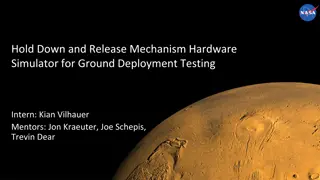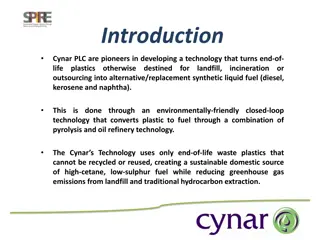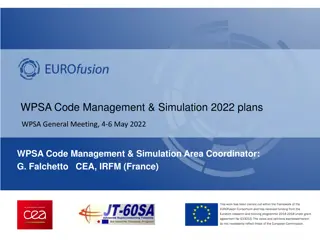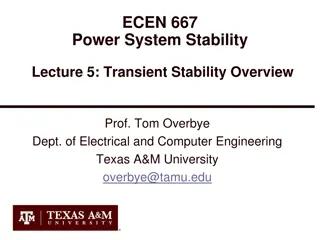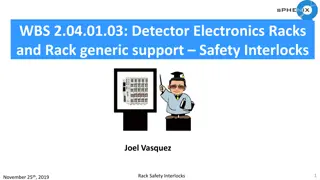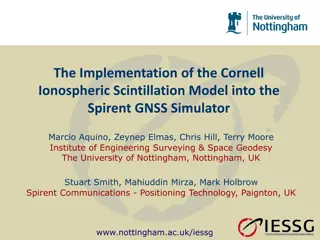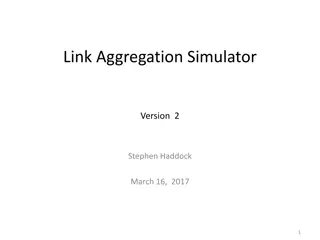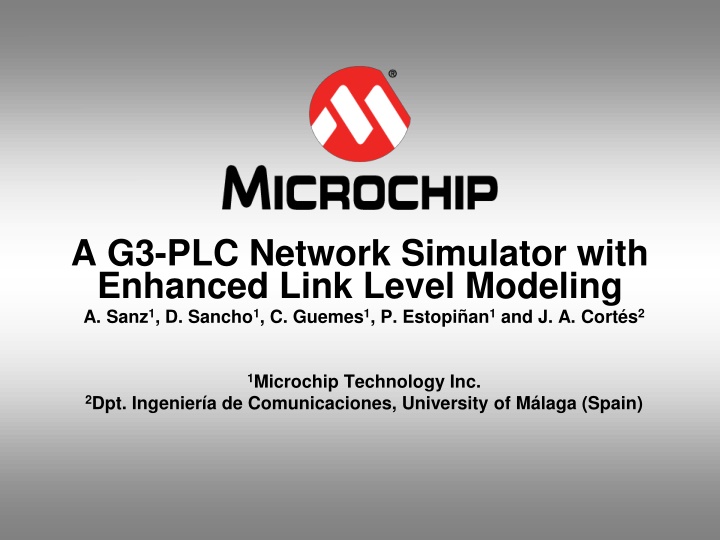
Enhanced G3-PLC Network Simulator
This work presents an enhanced G3-PLC network simulator that allows more accurate modeling and faster-than-real-time simulation of smart metering networks. The simulator architecture, event description, channel modeling, error estimation, and performance analysis are discussed in detail.
Download Presentation

Please find below an Image/Link to download the presentation.
The content on the website is provided AS IS for your information and personal use only. It may not be sold, licensed, or shared on other websites without obtaining consent from the author. If you encounter any issues during the download, it is possible that the publisher has removed the file from their server.
You are allowed to download the files provided on this website for personal or commercial use, subject to the condition that they are used lawfully. All files are the property of their respective owners.
The content on the website is provided AS IS for your information and personal use only. It may not be sold, licensed, or shared on other websites without obtaining consent from the author.
E N D
Presentation Transcript
A G3-PLC Network Simulator with Enhanced Link Level Modeling A. Sanz1, D. Sancho1, C. Guemes1, P. Estopi an1and J. A. Cort s2 1Microchip Technology Inc. 2Dpt. Ingenier a de Comunicaciones, University of M laga (Spain)
Contents Introduction G3-PLC Network Simulator Architecture Events description Channel model Frame error estimation Validation and network performance analysis Conclusion 2
Introduction Smart Metering network is the network that allows the remote management of elements of energy grid. The G3-PLC the OFDM specification suitable for this purpose. Network simulators are very useful tools for developing and debugging the communication stack. This work presents a G3-PLC network simulator enhanced to achieve a more accurate modeling while allowing faster than real-time simulation of complex networks. 3
G3-PLC Network Simulator: Architecture Each G3-PLC node is simulated by an independent process that implements the full stack, except most parts of the physical layer, and an event machine. Layers employing the same code used in actual G3-PLC Microchip. are implemented devices by A Control module commands the simulation and coherence. ensures its Frame transmission events are managed by the Network process, which implements the physical layer and the shared power line communications (PLC) channel. Taken from [2] [2] A. Sanz, P. J. Pi ero, S. Miguel, and J. I. Garc aa-Nicol s as, Distributed Event-Driven Simulation Environment for Smart Metering Protocols Evaluation, in Proceedings of the IEEE International Conference on Smart Grid Communications, 2012, pp. 151 156. 4
G3-PLC Network Simulator: Events description Example: Events associated to the transmission of two frames in a simplified scenario with three nodes plus the network coordinator. Frames transmitted by node 1 and node 3 reach the coordinator and node 2 with a signal level above the receiver sensitivity. Direct communication between node 1 and node 3 is not possible. Regions for error estimation R1 R2 R3 R4 Frame ID=2 Frame ID=1 Actual transmission FCH Payload Preamble Preamble FCH Payload t Coordinator CARRIER_DET FRAME_RX Coordinator Frame ID=2 Frame ID=1 TX_END Node 1 TX_START Node 1 Node 2 Node 3 Events Node 2 CARRIER_DET CHANNEL_IDLE TX_START TX_END Node 3 Interference level at the Coordinator 5
G3-PLC Network Simulator: Channel model The employed channel models allows simulating frequency selective channels with colored noise, including (simple) impulsive noise. Intercarrier and intersymbol interference is disregarded. The effect of the interfering frames is taken into account as an additive term independent of the desired signal and the channel noise. Consider a frame transmission from node s to node r. The transmitted frame consists of M OFDM symbols and employs the set of carriers K. The signal-to- interference-and-noise (SINR) at the receiver side for the constellation value received in the kth carrier of the mth symbol is given by Attenuation of the channel between nodes s and r for carrier k Power allocated by node s to carrier k Noise at node r in the band of carrier k Drawn from a RV in each frame! If node i is transmitting a frame while node r is receiving the desired frame, Ai(m)=1, otherwise Ai(m)=0 Set of interfering nodes 6
G3-PLC Network Simulator: Frame error estimation Frames are divided into regions for error estimation. Frame regions consists of an integer number of OFDM symbols with the same modulation and coding scheme and constant SINR. Example with 4 regions: Regions for error estimation R1 R2 R3 R4 Frame ID=2 Frame ID=1 Actual transmission FCH Payload Preamble Preamble FCH Payload t Coordinator CARRIER_DET FRAME_RX Coordinator Frame ID=2 Frame ID=1 TX_END Node 1 TX_START Node 1 Node 2 Node 3 Events Node 2 CARRIER_DET CHANNEL_IDLE TX_START TX_END Node 3 Interference level at the Coordinator -The FCH and the payload must be always in different regions because they use different coding schemes. -Interfering frames yield new regions. 7
G3-PLC Network Simulator: Frame error estimation Bit error probability (Pb) in each region is estimated from the Frame Error Rate (FER) as Number of data bits in the whole frame The FER corresponding to a channel state characterized by is estimated using the effective signal-to-interference mapping function (ESM), FER in AWGN channel where the effective SNR is given by on the channel state. where depends on the modulation and the coding scheme, but not 8
G3-PLC Network Simulator: Frame error estimation There is an optimum value of for each modulation defined in the G3- PLC system. They are computed as the solution to the minimization problem Effective SNR corresponding to channel state j fulfils Thousands of channel estates J have been used. For each channel state, the following process is followed to compute the values used in the optimization Estimated by simulations Generated Estimated by simulations Obtained from the definition 9
G3-PLC Network Simulator: Frame error estimation Optimum values of for the modulations used in the payload Using this procedure, the error between the actual FER and the estimated one is lower than 0.5 dB in 80% of the cases (channel states), except for BPSK in the FCC band, where this percentage is a bit lower, but still higher than 70%. 10
Validation and network performance analysis Test description Simulated results compared to the ones obtained in a test network deployed in the laboratory. Tested network: 100 nodes distributed in 5 levels. Flat attenuation of 50 dB between levels. A line impedance stabilization network (LISN) is used to control the noise level. The application layer emulates the DLMS/COSEM protocol. Simulation has been executed in a Dell Precision T7600 workstation. Results The simulated-time to real-time ratio for the tested network is 17/60, i.e. faster than real-time. 11
Conclusion A G3-PLC network simulator has been presented: The simulator implements the full stack using the same code that is embedded in actual Microchip G3-PLC devices. The implemented channel models allows simulating frequency selective channel responses and colored noise, which can be also time-varying. Frame errors are estimated using the ESM function and takes into account the possible collisions with other frames. The simulator has been validated by comparing their results to a test network deployed in the laboratory consisting of a coordinator and 100 meters distributed in 5 levels. Faster than real-time results obtained. Excellent match between simulations and measurements. 12



